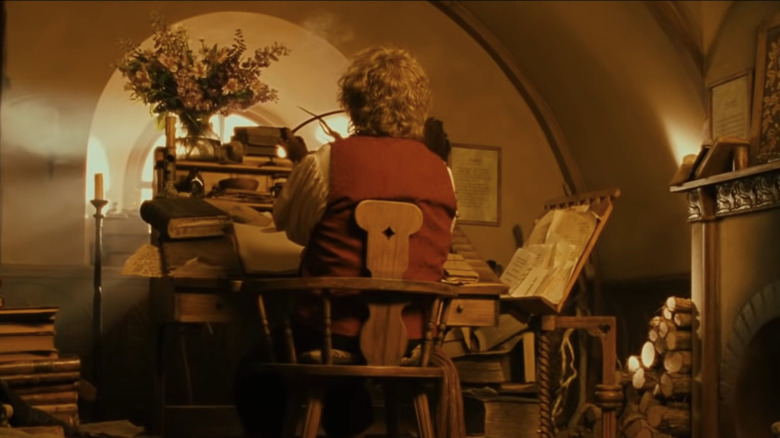How Lord Of The Rings' J.R.R. Tolkien Answered A Letter From The Real Sam Gamgee
J.R.R. Tolkien wrote a lot more than "The Lord of the Rings." Along with countless other Middle-earth material, he also answered mail — a lot of mail. So much mail that hundreds of the author's most fascinating letters with publishers, fans, friends, and family have been gathered into a book called "The Letters of J.R.R. Tolkien." One of these entries stands out not because of what Tolkien said but because of whom he was responding to.
The author penned the letter on March 18, 1956, six months after "The Return of the King" was published, addressing it to a Mr. Sam Gamgee, who lived in Tooting in South London. Mr. Gamgee had written five days earlier explaining that he had heard of "The Lord of the Rings," not in book form but as a serial on the radio. "I was rather interested at how you arrived at the name of one of the characters named Sam Gamgee because that happens to be my name," Gamgee wrote, adding, "I know it's fiction, but it is rather a coincidence as the name is very uncommon."
Tolkien's response starts with amazement. "You can imagine my astonishment, when I saw your signature!" The author appears to have been genuinely surprised that his S. Gamgee was not the only one in existence. He quickly adds, "I can only say, for your comfort I hope, that the 'Sam Gamgee' of my story is a most heroic character, now widely beloved by many readers." While the letter isn't long, Tolkien does take the time to briefly explain the origin of the name, adding that as a child, his local community used the term "gamgee" as another name for cotton-wool. "So in my story," he elaborates, "the families of Cotton and Gamgee are connected."
The U.K. Gamgees weren't gardeners
The explanation of the origin of Sam Gamgee's name from Tolkien's perspective is very simple. He adds that Sam is a rustic character, too. But the philologist doesn't stop with his own answer. He takes advantage of the opportunity to dive into the etymology of the real-life Gamgee family, too, and it turns out that the real Gamgees are much more prestigious than their bucolic counterparts in Middle-earth — at least before the whole "save the world from utter destruction" bit.
In the real Gamgee's original letter, the fellow explains, "I know it's fiction, but it is rather a coincidence as the name is very uncommon, but well known in the medical profession." That last bit about a renowned medical Sam Gamgee clearly piqued Tolkie's interest, and in his response, the author follows up on the point. After explaining his reasons for naming his character Sam Gamgee, he adds that "I know now, that 'Gamgee' was shortened from 'gamgee-tissue.'" This is a surgical dressing invented by none other than a J. S. Gamgee in the 19th century. Tolkien elaborates that he knows the inventor died in 1886, and a man who he presumes to be his son had died just a few weeks before their correspondence after years spent as the Professor of Surgery at Birmingham University.
"Evidently 'Sam' or something like it, is associated with the family," Tolkien adds, "though I never knew this until a few days ago, when I saw Professor Gamgee's obituary notice, and saw that he was the son of Sampson Gamgee." While the overall comparison is uncanny, Tolkien does use the italics to clarify that his character is Samwise, not Sampson or Samuel.
Tolkien and Sam kept writing after their initial encounter
Toward the end of the letter, Tolkien wrote, "Have you any traditions as to the real origin of your distinguished and rare name? Having a rare name myself (often troublesome) I am specially interested." Tolkien's biographer, Humphrey Carpenter, edited "The Letters of J.R.R. Tolkien," and after the letter ends, he includes the follow-up explanation. In it, he says that Mr. Gamgee sent a reply on March 30th with much more information about his family, doubtless to the delight of the Oxford professor.
As a final flourish in his initial response, Tolkien adds that if Gamgee is interested in reading the books, despite their length and fantastical nature, he could probably find them in the library, adding that they are very expensive to buy (just over £3 at the time). The last line reads, "I can only say that I shall be happy and proud to send you a signed copy of all 3 vols. as a tribute from the author to the distinguished family of Gamgee."
Carpenter says when he wrote back, Gamgee said he was delighted at the offer, and Tolkien sent them. "Mr Gamgee acknowledged their arrival," Carpenter concludes, adding that he said, "I can assure you that I have every intention of reading them."
The question is, which event gives the Gamgees more clout? Inventing a medical device or having a signed copy of what was presumably the first edition of "The Lord of the Rings"? Either way, neither one measures up to the fictitious Sam Gamgee's achievements, but it's a fun story all the same.


